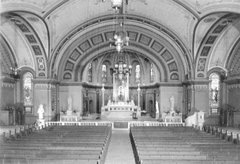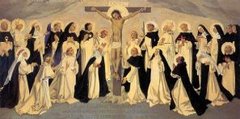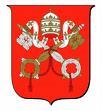Dr. Markey,
My name is Morris LeBleu and I am the Director of Communications for the Diocese of Lake Charles. I was forwarded your e-mail which included questions about the altars in our Cathedral church.
Here is a short explanation contained in a pamphlet about the structure.
The three Gothic altars were installed in 1923 and were originally housed in the Salt Lake City Cathedral. The Cent4ral altar is dominated by a statue of the Blessed Virgin under the title of Immaculate Conception. In the four niches, two at either side, are statues of the Evangelists: St. Matthew, St. Mark, St. Luke and St. John. These four statues are of Carrara statuary marble from Italy, the same type of pure marble Michelangelo used in his works.
The south chapel is dedicated to the Sacred Heart of Jesus and the north chapel to St. Joseph. The altrs of plain Carrara marble as is the surrounding flooring in the sanctuary.
The back story, as I understand it, is that a resident of Lake Charles was related to someone in the Diocese of Salt Lake City and may have had an "in" with the Bishop there. The altars and other various accoutrements were stored in a warehouse at the time and a deal was struck to send it to Lake Charles. It arrived in pieces on railroad cars but there were no directions as to how the pieces should fit together. A local stonemason, whose family remains in the business to this day, was called upon to figure out the 'puzzle'.
The church building (that would become the Cathedral of the Diocese of Lake Charles in 1980) was completed and dedicated in 1913, three years after a devastating fire destroyed the previous church, school, and convent as well as a nearly all of the other buildings in the community. It was, at the time, considered one of the finest examples of Lombardy Romanesque architecture in the United States and was dedicated by Archbishop James Blenk of New Orleans. The Cathedral will celebrate its centennial next year.
The church parish was founded in 1869, then named St. Francis de Sales, and responsible for Catholics in a 5,000 square mile area of Southwest Louisiana. In 1927 the church was solemnly consecrated to the Immaculate Conception.
Work is being done now by volunteers at the Cathedral on a more in depth history of the parish and the church. You may wish to contact the Cathedral directly - 337-436-7251 - if you wish any further information. Also, there could be further clarifications to the story on the altars about which I have not been made aware.
Thank you and God bless you.
Morris J. LeBleu
Director of Communications
Diocese of Lake Charles
411 Iris Street
Lake Charles, LA 70601
Ready or not, several weeks from now we Americans will begin to make some decisions about those whom we want to see as candidates for public office in the elections of November, 2008. Recent national elections have been quite contentious, to say the least. Unfortunately, the efforts of American bishops to offer some reflections on Catholic teaching and political life seem to have made matters worse, in the eyes of many. This will occur, of course, when folks confuse ethics with religion.
One public servant was recently discussing one of the most controversial of all issues in the last election, namely, legal abortion. It was his contention that someone could have a deeply held belief that all life, including that of unborn infants, is sacred. But at the same time he or she could rightly accept the fact that in a pluralistic society making all abortions illegal would constitute an unfair imposition of those beliefs on others. The problem with that statement is that the wrongness of abortion is not a matter of belief. It is a matter of ethics in a civilized society.
Killing another person is not wrong simply because it’s prohibited in the Ten Commandments. It’s wrong because it is unethical. It goes against the reasonable and well-founded standards of society from time immemorial. Even if everyone were to accept abortion, it would remain unethical. Americans accepted slavery for a long time. But it wasn’t ethical. Being ethical is much more than simply doing whatever society accepts.
In making a decision about how to vote in the coming elections, we citizens have a serious responsibility to examine the issues of the day and the positions which the candidates take vis-à-vis those issues. Catholics certainly should try to understand what the church teaches about issues that affect public policy. But not everything the church says about issues stems from belief. Many are positions ethically-based, reinforced by the moral values we share as disciples of Jesus Christ.
At the recent meeting of the American bishops in Baltimore, we discussed a statement entitled “Faithful Citizenship,” which is intended to help our people form their consciences about matters of public policy. Similar statements have been used widely in the past in our parishes and dioceses. Outsiders, and even some Catholic insiders, see this as an intrusion upon their freedom of conscience. Catholics, of course, have the obligation to form a right conscience, one in keeping with church teachings. But other folks also need to make their decisions based on ethical standards. Feelings, laws and social norms do not determine what is ethical. Sound reasoning does.
Because of the consistent confusion between ethics and religion, it is important for Catholic teachers like bishops to clarify positions they take. Are these moral convictions based on church teaching? Or are these ethical convictions, based on human reason, illuminated by Scripture and the teaching of the church? Yes, the church teaches it is wrong to kill, to steal, to perjure oneself, to defame a neighbor, to marry one’s own parent or child. These are not matters of religious belief. They are ethical concerns. By that same token, the observance of Sunday as a holyday, liturgical directives, the personal consequences of sinful behavior, penitential practices, all these are religious in nature, pure and simple.
In the coming elections, there are some policy goals that we bishops would like our people to keep in mind in the light of ethical principles. Our purpose in sharing these is to help parishioners form their consciences and reflect on the moral dimensions of their public choices. All issues are not equal. They do have different moral weight and urgency. But it is important to ask our candidates how they intend to help our nation pursue these goals:
1) the pre-eminent requirement to protect the weakest in our midst, namely, innocent unborn children;
2) how to keep our nation from turning to violence to address fundamental problems, including the violence of abortion, euthanasia and assisted-suicide;
3) defining the central institution of marriage as a relationship between one man and one woman and providing better support for family life;
4) achieving comprehensive immigration reform that secures our borders and treats all people with respect and dignity;
5) helping families and children overcome poverty, particularly with respect to ensuring access to and choice in education as well as decent work and decent wages;
6) providing health care coverage for the growing number of our fellow citizens;
7) opposing policies that reflect prejudice, hostility toward immigrants, religious bigotry and all forms of discrimination;
8) working together to overcome poverty, pursue the common good and care for creation;
9) establishing and complying with moral limits on the use of military force; and
10) joining with others around the world to pursue peace, protect human rights and religious liberty and advance economic justice in care of creation.
While these issues are being debated, over the next six weeks we Catholics will be pondering with Mary, the Mother of the Church, the great mystery of the Incarnation. God became man, thrusting himself into our midst, and changing the human family forever. This is a religious truth, not an ethical conviction. But it is the greatest truth we can tell. In response to the Lord’s coming, which we shall be celebrating during the weeks of Advent and Christmas, we want to ground ourselves more surely in his teachings about all human life and to do our part as a community with a rich heritage of ethical convictions to confront the many challenges in public life and thereby promote peace on earth and good will to all people.





.JPG)





























